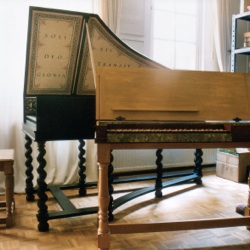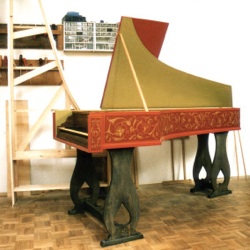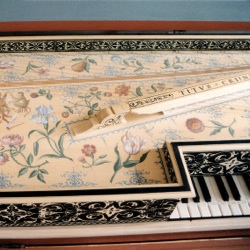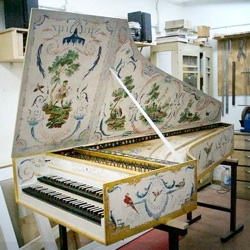
MODELS
I.I. COUCHET 1679
-
‣single manual
-
‣range: C - c3 or GG/BB - d3
-
‣2 x 8´ (on one string) plus 1 x 4´ / lute stop
-
‣length: 1,93 m.
-
‣possibility to transpose a1: 415-440 Hz.
G.B. GIUSTI 1681
-
‣single manual
-
‣¨false inner outer¨
-
‣fir soundboard and brass strings
-
‣range: C/E - c3 or C - d3 chromatic
-
‣2 x 8´ or 1 x 8´ plus 1 x 4´
-
‣keyboard: boxwood naturals, ebony sharps
-
‣length: 1,95 m.
-
‣possibility to transpose a1: 415-440 Hz.
-
‣decoration: Cornelis Verboom
I. RUCKERS 1624 grand ravalement
-
‣double manual (single manual possible)
-
‣range: FF - f3
-
‣2 x 8´ plus 1 x 4´ / lute stop
-
‣length: 2,27 m. for double manual
-
‣possibility to transpose a1: 392-415-440 Hz.
-
‣decoration: Cornelis Verboom
F. et N. BLANCHET 1733
-
‣double manual
-
‣range: FF - f3
-
‣2 x 8´ plus 1 x 4´
-
‣length: 2,38 m.
-
‣possibility to transpose a1: 392-415-440 Hz.
-
‣decoration: Elena Felipe
Below is a listing of the instruments that I make on a regular basis.
Some words on the ravalements: The difference between a petit and a grand ravalement is not just the compass.
Starting point for a ravalement would be a Flemish harpsichord with a compass of (sounding) GG - c3 with one 8’ and one 4’ string per note.
To make a petit ravalement the maker would add a second 8’ string (the long one) to the existing one and, from the second half of the 17th century, fit a keyboard that was one natural key wider (d3) in the harpsichord case by eliminating the key end blocks and reducing the size of the keys. The result was an increase of the scaling by about one semitone. This longer scaling was not a problem: due to the lower pitch used in France the string tension would not raise (and cause strings to break).
To make a grand ravalement the maker would remove the cheek, add 4 or 5 cm. to the bentside, enlarge the pinblock and reinstall a new cheek. This would widen the case to the treble. Adding the extra FF and FF# in the bass meant that the new keyboard would shift to the right compared to the original configuration. The consequence is that the scaling shortened. The addition of the second 8’ string (the long one) would more or less compensate for this but the instrument would be used at a lower pitch (as mentioned before) which results, for equal string diameters, in a lower string tension.
The higher string tension in a petit ravalement compared with a grand ravalement of the same original gives a tone that is more penetrating, perhaps a bit more brilliant, a bit more talkative: a bit ¨earlier¨, where the grand ravalement has a rounder or warmer, ¨later¨, sound.
A. Ruckers 1640
-
‣single manual
-
‣range: C/E - c3 or GG/BB - d3
-
‣1 x 8´ plus 1 x 4´ or 2 x 8´ / lute stop
-
‣length: 1,82 m.
-
‣possibility to transpose a1: 392-415-440 Hz.
-
‣decoration: Elena Felipe




I. Ruckers 1640
-
‣5 foot muselar
-
‣range: C/E - c3
-
‣keyboard: bone naturals, ebony sharps
-
‣length: 1,47 m., width 0,49 m.
-
‣decoration: Cornelis Verboom


I. RUCKERS 1624 petit ravalement
-
‣double manual (single manual possible)
-
‣range: GG without GG#- d3
-
‣2 x 8´ plus 1 x 4´ / lute stop
-
‣keyboards: ebony naturals, bone covered sharps
-
‣length: 2,25 m. for double manual
-
‣possibility to transpose a1: 392-415-440 Hz.
-
‣decoration: Elena Felipe
Chr. VATER 1738
-
‣single manual
-
‣range: BB - e3
-
‣2 x 8´
-
‣length: 2,00 m.
-
‣possibility to transpose a1: 392-415-440 Hz.
-
‣decoration: Elena Felipe

